Pennsylvania is a moderately sized state, with Philadelphia on the east coast and Pittsburgh on the west coast. Between those two cities are many miles of farmlands, mountains, forests, and many types of animals.
Among them are snakes, both venomous and non-venomous. We’re going to take a look at the three species of venomous snakes in Pennsylvania, so you know what to watch out for when exploring this beautiful land.
The Four Types of Venomous Snakes Found in the United States
The United States is home to only four genera of venomous snakes, but many species of them exist. The four types of venomous snakes you can find in the United States are:
- Rattlesnakes
- Copperhead Snakes
- Coral Snakes
- Cottonmouth Snakes
All these snakes are dangerous for different reasons. Rattlesnakes are widespread, have deadly venom, and live in areas that are rife with people. Copperhead snakes blend into their surroundings very well and can deliver a fatal bite. Coral snakes have very deadly venom, and they are often confused for kingsnakes, non-venomous snakes. Cottonmouths are often found near water, so they come into contact with fishers and pets.
Fortunately, these snakes all have treatable venom, but they are still capable of inflicting horrible wounds on humans.
The Three Poisonous Snakes in Pennsylvania
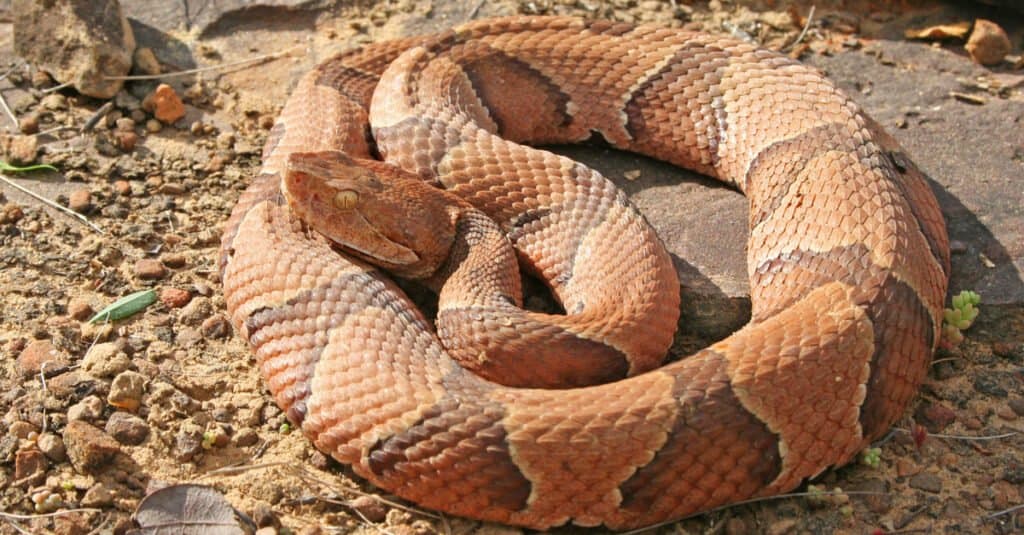
The copperhead’s scales are keeled, and its eyes have vertical pupils that resemble a cat’s eyes.
©Creeping Things/Shutterstock.com
The three venomous snakes in Pennsylvania are the timber rattlesnake, the eastern Massasauga rattlesnake, and the copperhead snake. Two of them belong to the same genus, rattlesnakes, but the copperhead belongs to a different genus.
Overall, Pennsylvania has been home to 21 species of snakes, and three species of those snakes in Pennsylvania are poisonous. Not all the 21 species of snakes that have been recorded in Pennsylvania are widespread. In fact, some of them may not be endemic to the state anymore.
For better or worse, all three venomous snakes in the state are still present. That means hunters, farmers, and explorers need to be careful and know how to recognize these animals. Let’s take a closer look at each of the three venomous snakes that you can encounter in Pennsylvania.
Timber Rattlesnake
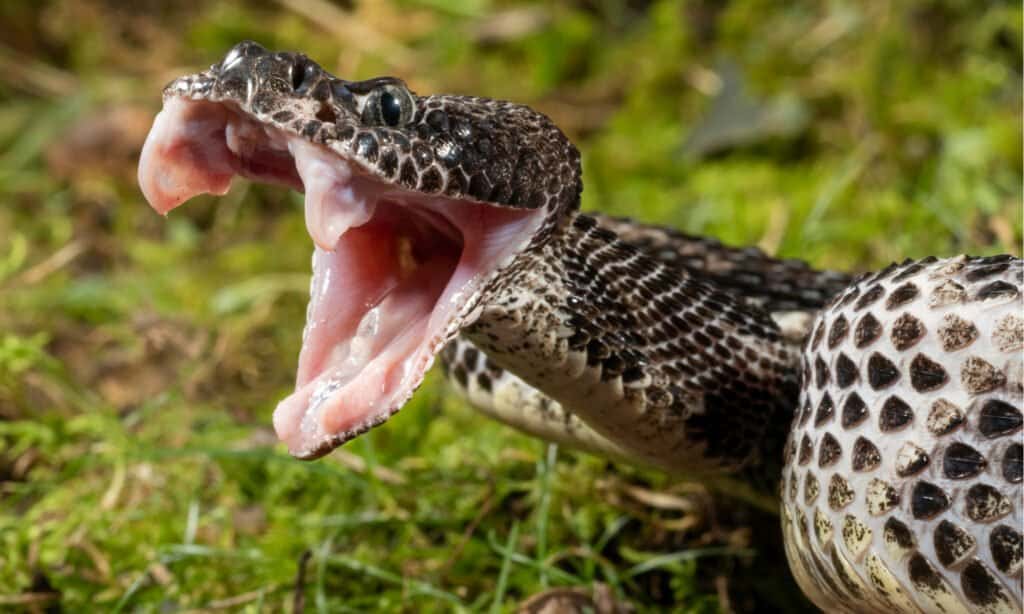
The timber rattlesnake is the largest venomous snake in Pennsylvania.
©Joe McDonald/Shutterstock.com
| Size | Color | Unique Qualities |
|---|---|---|
| 3ft-7ft long | – Dark zig-zag patterns set against brown, gray, or pinkish skin | – Known for its rattling defense posture |
The timber rattlesnake, also called the canebrake rattlesnake, is widespread throughout Pennsylvania, and it is a very deadly snake. Many of the venomous snake deaths in the United States are attributed to this snake.
Many people operate under the false assumption that rattlesnakes have to rattle before they bite. Also, some people believe that these snakes always rattle. Neither of these myths is true. If you step on a timber rattlesnake, it will probably bite you without warning.
Timber rattlesnakes tend to inhabit the mountainous central portion of the state from the northern to southern reaches. They are less common in the far western or eastern parts of the state. Individuals that spend time on the Appalachian trail may encounter them.
These snakes vary in color and size, but their trademark rattle is a dead giveaway for them.
Eastern Massasauga Rattlesnake
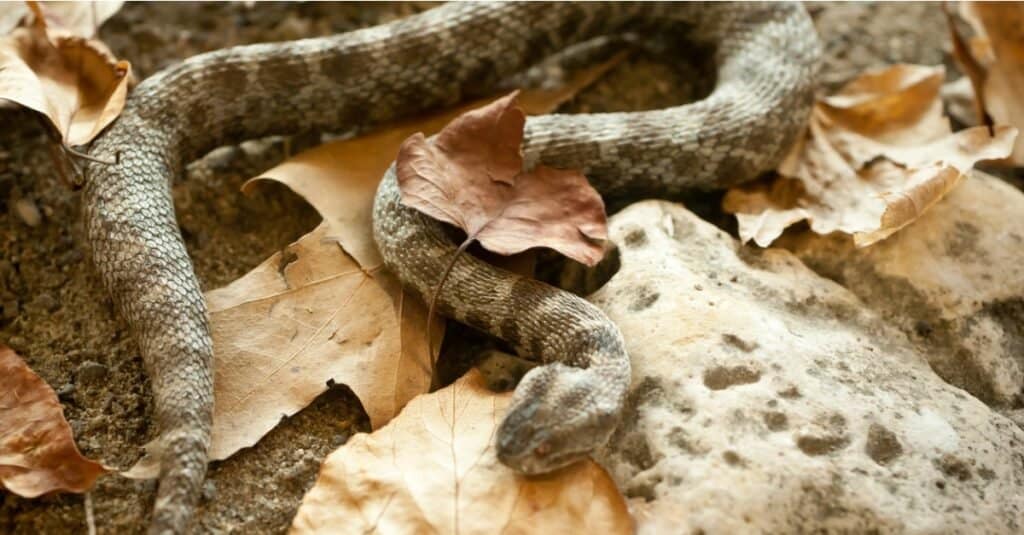
Massasaugas are small snakes with thick bodies, heart-shaped heads, and vertical pupils.
©iStock.com/Westhoff
| Size | Color | Unique Qualities |
|---|---|---|
| 2ft-2.5ft long | – Brown, grey, black, tan – Dark brown or black splotches down the back and sides | – Known for its small rattle and resemblance to other snakes |
Don’t be confused by the Massasauga name. These are rattlesnakes, they’re venomous, and they’re a perfectly good reason to stay away from unfamiliar wildlife. Massasauga snakes are easily confused for hognose snakes, milk snakes, and fox snakes. As a result, people may think these snakes are not deadly. Make no mistake about it: these snakes are small, but they can kill people.
The chances that you will encounter these snakes are somewhat low. They are endangered species, and they prefer to live in lowlands, marshy areas, and woods. Even so, they can be hard to see due to their relatively small size and their color.
If you find yourself in those areas, then make sure to exercise caution. If you keep your eyes and ears open, you’ll have a good chance to avoid these snakes.
Copperhead Snake
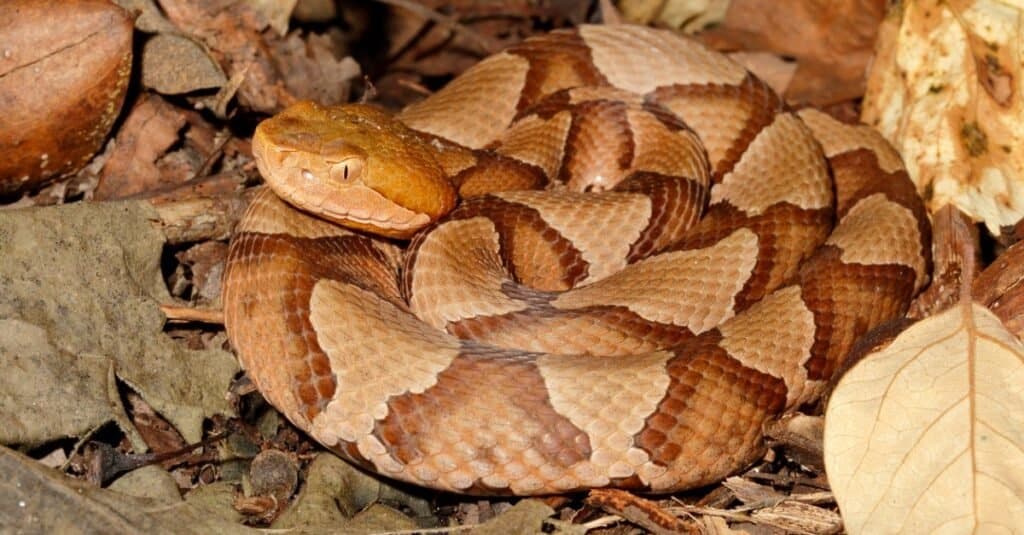
Northern copperheads can mimic the rattle of a rattlesnake.
©iStock.com/David Kenny
| Size | Color | Unique Qualities |
|---|---|---|
| 2ft-4ft long | – Brown, tan, yellow – Dark brown or red hourglass-shaped blotches on its back – Blends in well with leaves and soil | – Great camouflage and widespread |
Copperheads are the most common of all poisonous snakes in Pennsylvania. These snakes are hard to see. Their colors allow them to blend in with dirt, detritus, and leaves. These snakes can be found in a wide variety of areas in the state. Although they do not possess a rattle, they will make their tail vibrate a great deal to scare off potential prey.
Although the copperhead is a common snake, it’s not highly aggressive. As long as you carefully examine where you’re walking, you should be able to avoid a bite.
How Many People Do Poisonous Snakes in Pennsylvania Kill Each Year?
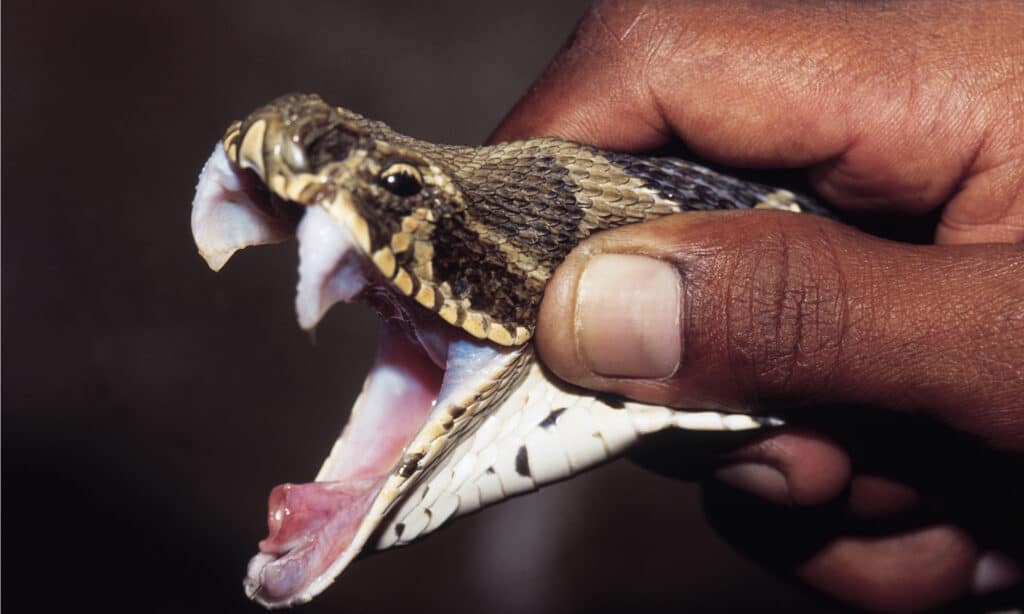
Few people die from venomous snake bites in the U.S., and Pennsylvania rarely sees snakebite deaths.
©RealityImages/Shutterstock.com
Roughly 7,000-8,000 venomous snakebites are recorded in the United States each year. About five of those individuals die as a result of the snakebite. In Pennsylvania, venomous snakebites are very rare, and the state has gone many years without a fatal venomous snakebite.
A fatal rattlesnake bite in 2015 was the first death from a venomous reptile since 2001. Also, that incident was the first fatal rattlesnake bite in 25 years. Fatalities from snakebites are exceptionally rare, and they usually happen when a person attempts to handle a snake or by accident.
Staying safe from venomous snakes in Pennsylvania is not very difficult. Being mindful of your surroundings and knowing common areas where dangerous snakes are found are two very helpful ways to avoid trouble.
Moreover, you should know what to do if you encounter a venomous snake. If you hear a rattle, stop what you’re doing, identify the source of the noise, and back away without any sudden movements. If you see a snake you don’t recognize, don’t approach it. These are a few helpful methods to avoid dangerous interactions with reptilian wildlife in Pennsylvania.
Other Reptiles Found in Pennsylvania
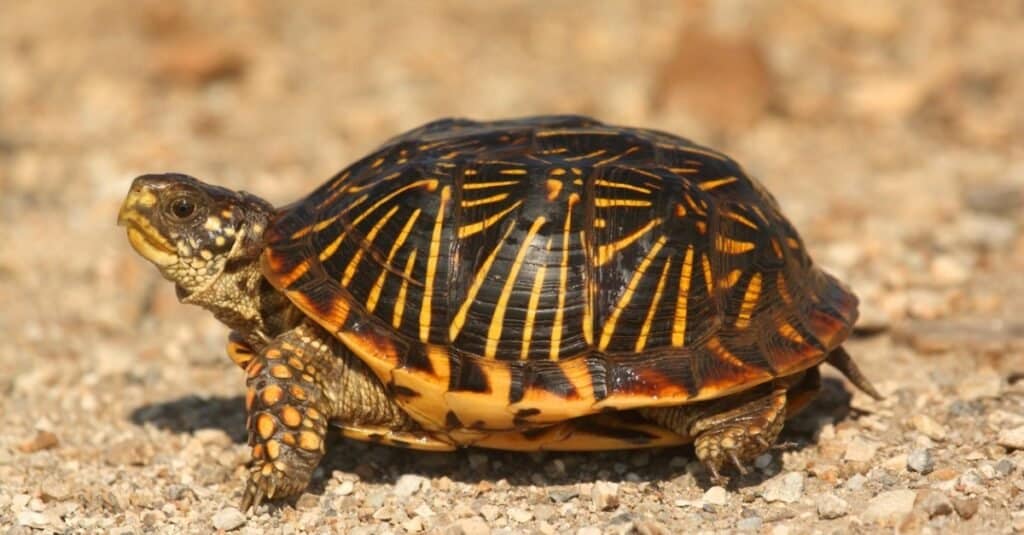
The common box turtle calls Pennsylvania home, among a few other states.
©iStock.com/SteveByland
Pennsylvania is home to a variety of reptile species, from harmless garter snakes to venomous copperheads and rattlesnakes. These cold-blooded creatures can be found in a range of habitats, from forests and fields to wetlands and streams.
The state’s diverse landscape provides an ideal home for many reptile species, including turtles, lizards, and snakes.
Here is a list of other reptiles that are found in Pennsylvania:
- Common Five-lined skink
- Broadhead skink
- Eastern fence lizard
- Common snapping turtle
- Common musk turtle
- Wood turtle
- Smooth softshell turtle
- Common box turtle
Bonus: A Coral Snake or a Milk Snake?
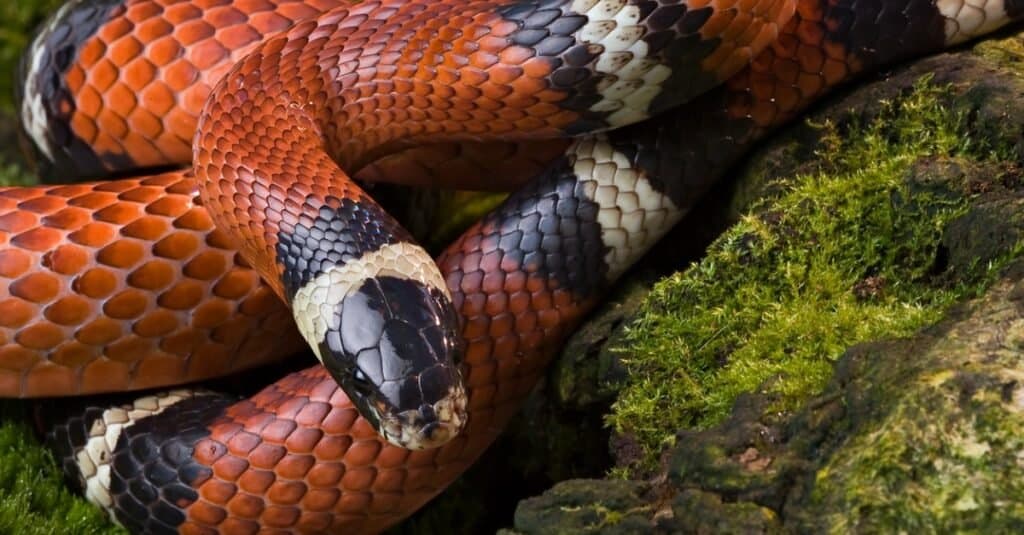
Milk snakes could easily be mistaken for venomous coral snakes, but milk snakes are harmless to humans and even make good pets.
©iStock.com/wScottLoy
Before you get out your shovel, ready to behead that coral snake (we prefer that you don’t take that action either way), there’s a coral snake look-a-like that is non-venomous and may be helping you keep the rodent population down. The milk snake has banded markings that are almost the same as a coral snake, as well as its thin, long body and head shape.
On appearances alone, the best way to tell them apart is by their coloring and patterns. Coral snakes are more brightly colored, typically with black, red, and yellow bands. The black and red bands are wider with thin yellow outlines separating each. Milk snakes, on the other hand, are often red, black, and yellow or varying shades with darker colors outlined with wider sections of black.
Another key difference between these snakes is the method of killing prey. While milk snakes squeeze prey to death by constriction, coral snakes utilize their venom to kill prey. Coral snakes typically eat frogs, lizards, and other snakes.
Finally, milk snakes grow longer on average than coral snakes, typically averaging 14 to 69 inches, while coral snakes grow from 18 to 36 inches.
The photo featured at the top of this post is © iStock.com/Westhoff
Discover the "Monster" Snake 5X Bigger than an Anaconda
Every day A-Z Animals sends out some of the most incredible facts in the world from our free newsletter. Want to discover the 10 most beautiful snakes in the world, a "snake island" where you're never more than 3 feet from danger, or a "monster" snake 5X larger than an anaconda? Then sign up right now and you'll start receiving our daily newsletter absolutely free.
Thank you for reading! Have some feedback for us? Contact the AZ Animals editorial team.






